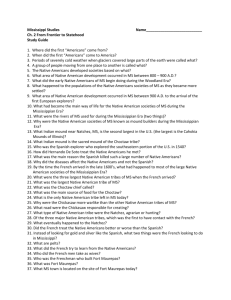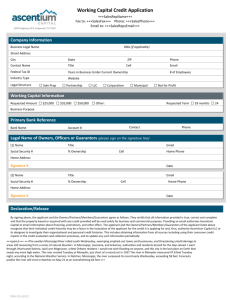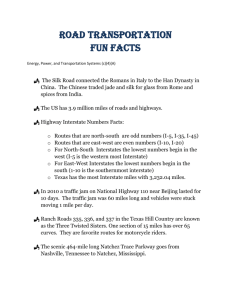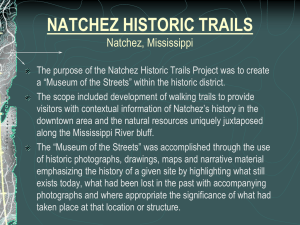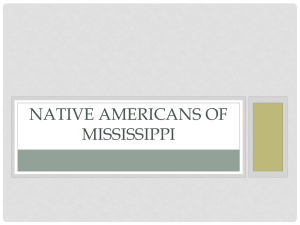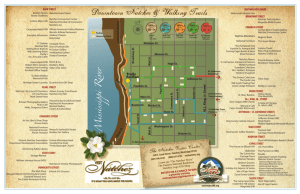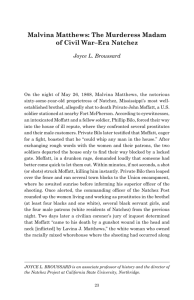Chapter 3 The Road to Statehood Early Native Americans
advertisement
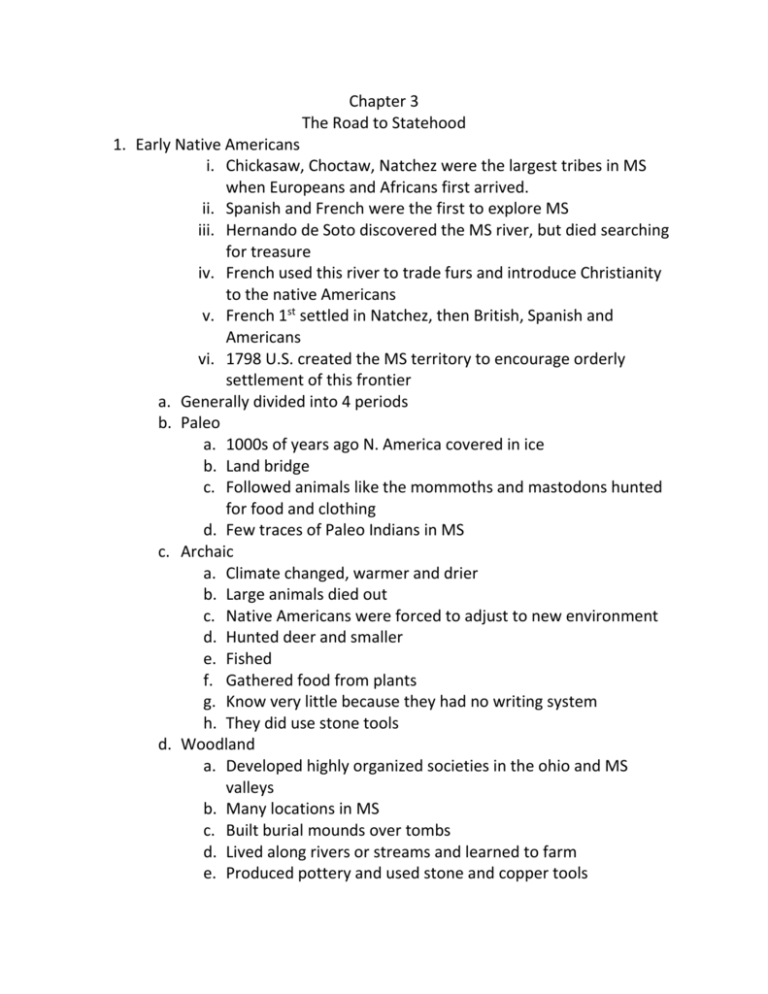
Chapter 3 The Road to Statehood 1. Early Native Americans i. Chickasaw, Choctaw, Natchez were the largest tribes in MS when Europeans and Africans first arrived. ii. Spanish and French were the first to explore MS iii. Hernando de Soto discovered the MS river, but died searching for treasure iv. French used this river to trade furs and introduce Christianity to the native Americans v. French 1st settled in Natchez, then British, Spanish and Americans vi. 1798 U.S. created the MS territory to encourage orderly settlement of this frontier a. Generally divided into 4 periods b. Paleo a. 1000s of years ago N. America covered in ice b. Land bridge c. Followed animals like the mommoths and mastodons hunted for food and clothing d. Few traces of Paleo Indians in MS c. Archaic a. Climate changed, warmer and drier b. Large animals died out c. Native Americans were forced to adjust to new environment d. Hunted deer and smaller e. Fished f. Gathered food from plants g. Know very little because they had no writing system h. They did use stone tools d. Woodland a. Developed highly organized societies in the ohio and MS valleys b. Many locations in MS c. Built burial mounds over tombs d. Lived along rivers or streams and learned to farm e. Produced pottery and used stone and copper tools f. The presence of copper so far from it’s source suggests mounduilders were part of a wide ranged trading system. g. As their villages gradually grew larger and tied together politically h. Toward the end of this period they began using the bow and arrow e. Mississippian a. 1000-1600 ad b. Burials on flat rectangular mounds c. The second largest in the U.S. is Emerald Mound located near Natchez d. Several notable mounds around the state i. Nanih Waiya- Choctaw, 22 feet high 218 long 140 wide ii. Great village- Natchez, layers 1. One mound is base for temple and bones of leaders were kept here 2. The Great Sun lived atop another mound e. Built villages surrounded by wooden defenses f. Located near rivers or creeks g. Fertile and easy to plow by hand for crops h. Crop was Maize AKA corn, beans, squash i. Used bow and arrow j. By the 1600s the moundbuilders were replaced by the Native Americans f. Native American Societies a. Most of the N.A. (Native American) societies in MS were fairly small b. Largest, Choctaw, Chickasaw, Natchez c. NAs across the Southeast U.S. spoke very similar languages d. And had very similar religious beliefs e. NA’s in MS were well organized i. Each village governed itself and sent reps to tribal councils f. Within each village were several clans i. Served as protection, revenge, and arranged marriages ii. When married, children were considered part of mother’s clan iii. In this society the closest male relative to a boy was not father, but mother’s brother iv. Occasionally a man would have more than one wife v. Near rivers and creeks vi. Men cleared land, constructed buildings, hunted, and fought vii. Women planted, harvested, made pottery, gathered food viii. Religion focused on the sun and sacred fires 1. Believed in many spirits assoc. animals and nature 2. Explain, ishtohbohl and chunky ix. The Natchez and Great Sun 1. Continued more of the practices of the MS culture than their neighbors 2. Great sun rode in a litter with his wives and when he died some of his wives and other members of the tribe were burred with him. 2. European Explorers 1. Christopher Columbus’s voyage in 1492 sparked European Exploration of North and South America. 2. Explorers told stories and settlers followed 3. The people emigrating into the U.S. had to have both courage and endurance to survive the trip and once here. 4. With this new arrival, NAs had to defend the land they had lived in for thousands of years a. Spanish Explorers i. The first Europeans in MS ii. 1539-1542 Hernando de Soto explored the Southeastern part of N. America in search of silver and gold 1. 600 soldiers mostly on horses 2. Brought hogs as source of food 3. Both horses and hogs were introduced to America by the Spanish iii. Started near Tampa Bay and went north as far as north Carolina, until he turned west and south iv. He obtained guides, supplies and people to carry things by holding Indian chiefs hostage v. 1540 a surprise Indian attack near Mobile almost ended his expedition vi. He needed something to show for his troubles so he continued NW entering MS vii. 1541 another attack forced de Soto to go further west viii. In May the tired soldiers reached the MS river, built boats and crossed it. ix. He died in 1542, his men buried him secretly and tried to walk to Mexico. x. They changed their minds, came back, built barges and sailed down the MS river 1. Pursued by Indians in dugout canoes xi. The survivors reached the Gulf and sailed to Mexico xii. Less than half that started survived xiii. Killed 4000 or more Native Americans during this expedition xiv. Spanish did not return, because there was no silver or gold found xv. The most important result was the spread of disease from Spanish to Native Americans, who had no immunity to them xvi. Because of trade routes the NAs took the diseases to places far from where de Soto travelled xvii. Studies show that the NA population decreased around 50% in the South east after this b. French Explorers i. French were the next to come to MS ii. Quebec and looking for a water route to the Pacific iii. Found the Great Lakes and went south trading furs and spreading Christianity iv. La Salle, Tonti, and Cavelier travelled all the way down the MS river to the Gulf, and claimed for France v. La Salle later returned and tried to establish a settlement at the mouth of the MS vi. He died 3. European Settlements i. England, Spain, and France ii. Rivals in Americas and fought a series of wars iii. This caused things to change 1. Territories controlled by each country changed 2. Colonies sought allies with NAs 3. MS went from French, to British, to Spanish 4. U.S. finally gained control in 1798 b. French Settlement i. From their base in Quebec they wanted to control the interior of the North America ii. Wanted to dominate the fur trade and keep the English confined to the coast iii. Needed firm grip on Ohio and MS river valleys iv. 1699 French sent d’Iblerville to establish a settlement on the coast, he chose Ship Island off the coast of MS 1. Built Fort Maurepas on present site of Ocean Springs 2. 1st European Settlement in MS 3. Later he also established settlement at Mobile 4. Abandoned Fort Maurepas because of poor water supply, few people to trade with, no easy access to interior. v. Bienville established a new base and called in New Orleans at the mouth of the MS 1. He also built Forts Rosalie at modern Natchez and Fort St. Pierre where the Yazoo river meets the MS, present day Vicksburg 2. Fort Rosalie prospered until demanded neighboring Natchez village surrender to them a. Natchez responded by attacking, killing over 200 white people and setting all of the black slaves free b. French then wiped out the Natchez Tribe with the help of Choctaws and the survivors of Natchez fled to the Chickasaw. c. The Native Americans and Europeans i. Main problem for the NAs was there lack of unity ii. Never solid unified and before Europeans, fought themselves iii. French and British were always at war with themselves 1. Bought NA allies with trading guns and gunpowder 2. Choctaw sided with French 3. Natchez, Chickasaw and Creek sided with British 4. Chickasaw raided Choctaws and sold POW into slavery 5. French and Choctaws in return attacked Chickasaws near Tupelo but were defeated iv. French and Indian war eventually erupted between British and French v. A civil war between the Choctaws ensued between those siding with French and others siding with British vi. In MS the French Choctaws won, but the British defeated the French and forced the treaty of 1763 1. French lost all territory east of MS river except New Orleans 2. MS was now British d. British Mississippi i. After the treaty of 1763, MS became part of the west Florida territory and was unimportant to England ii. England encouraged the settlement of the Natchez district giving war vets land grants 1. By 1774 about 3000 black and whites lived in the Natchez district 2. During the American Revolution, after the Spanish declared war on England, the Spanish captured Natchez 3. The treaty of Paris gave U.S. land east of MS River, an North of 31 degrees, but Spanish refused to give up the Natchez district and kept it e. Spanish Mississippi i. Under Spanish rule the district prospered ii. Triple in size in 13 years iii. The governor encouraged immigration to this district by giving land and accepting protestant denominations iv. The land proved to be quite fertile and began farming first tobacco and indigo, but later cotton increased. v. By 1800 they were exporting 3 million pounds of cotton, 1/6 of the total cotton export of the Americas vi. The Pinckney’s treaty of 1795 gave U.S. ability to deposit good in New Orleans and gave the U.S. the Natchez district vii. U.S. did not take the district until 1798 4. Mississippi Territory i. When the U.S. began to govern MS, NAs were the largest portion of the population ii. MS was a frontier, full of deer, turkey, and bear iii. Roads were really just trails for walking or horses, not wagons iv. The Natchez trace, the route from Natchez to Nashville was little better v. Gradually, establishments known as “stands” dotted the trace. Motels vi. Natchez was the main town and port to get supplies in and out a. Territorial Government a. NW ordinance prohibited slavery north of the Ohio river b. Not below it c. 3 stages to being admitted as a state i. The President appointed a territorial governor, 3 judges, and a secretary to the governor 1. When the population reached 5,000 adult free men, the second stage began ii. Voters could pass laws and elect a territorial delegate to represent them in congress iii. Began when a territory had 60,000 people (excluding Indians b/c they were not taxed) 1. At that point voter elected delegates to a constitutional convention, which wrote the state constitution. 2. After congress approved the constitution the territory became a state with the same privileges of any original 13 states. d. When President Jefferson appointed the second Governor of MS territory, W.C.C. Claiborne, he moved the capital from Natchez to Whatington, a small town i. This was an attempt to relate to farmers b. Land a. Disputes began to arise about MS’s land b. Choctaws and Chickasaws owned most of the land i. And even though they had ceded and sold some land the pressure was mounting for the U.S. to gain the rest of it c. Land Titles over-lapped from England, France, Spain and even Georgia, and on top of this were Squatters i. Resolving this took years d. Land Ordinance of 1785 i. Divided land into townships and sections ii. Townships were 6 miles square with 36 sections iii. Each section was 640 acres iv. Section 16, was given to the people to rent or sell to pay for public education e. Sectionalism i. West/slave owners vs. eastern who thought wealth was running gov f. 1804 territory was extended to Tennessee after Georgia gave up its claims. g. In 1812 MS extended to the Gulf Coast when the Spanish lost their claims on west Florida h. Territorial period lasted less than 20 years i. Personal conflicts often led to duels and deaths j. During the war of 1812 Andrew Jackson led soldiers to defeat the Creek Indians and opened more land in modern day Alabama to be settled c. Statehood a. Congress divided the MS territory into 2 states in 1817 b. Alabama Territory would become a state in 1819 c. Once the new MS boundaries were set a constitution had to be written i. The political elites met in Washington, MS to write it d. The 1st State constitution was cautious and conservative i. Legislative branch was given more power than the executive branch ii. Only legislators, governor and lieutenant governor were elected 1. The rest of the state officers were appointed 2. Judges were appointed for life 3. Senators were based on the number of taxpayers of that county 4. Blacks and non-paying whites were not counted 5. The constitution was not sent to the voters, but straight to Federal government 6. On December 17, 1817 MS became the 20th state in the U.S.
